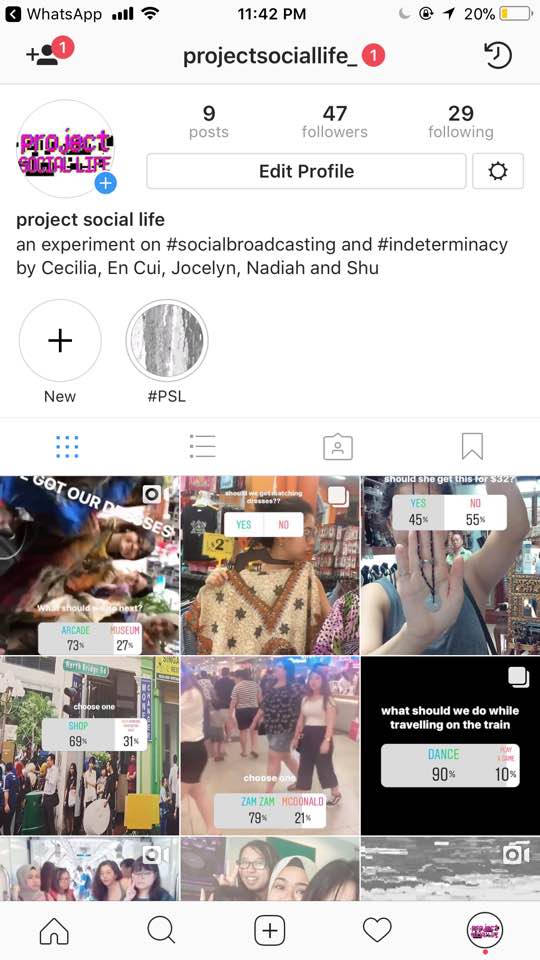Project Social Life. Project Social Life is an interactive online social performance. In this experiment, we test the power of social media in our lives and the effects of losing control over our lives. Our project revolved around Instagram. Instagram was our source, our outlet, and our dictator. To test this, we created a separate Instagram account and constantly asked the question, “What should we do next?” on our Instagram Story. There would be a poll attached to each question with two options sent in by our followers in the beginning of the experiment. Our group would then wait ten minutes and do the option with the most votes, following the idea that we have no control over our actions but social media does.
Sneak Peak:
Our entire day was curated by social media and the decisions of other people we barely know. We wanted to show people the power of social media in our lives and how it feels to be puppets held by the hands of strangers. Much like Finding Uncle Roy, a Blast Theory work that focused around the concept of trusting strangers, we put our trust and life in the hands of strangers. We started off the experiment in ADM NTU but due to the demands of the people, we ended up in Haji Lane after a long subway journey. I like the rest of my group mates, was in charge of the Instagram account as well as one of the “victims” of social media and the lack of control.
While the entire point of our project was to embrace the unexpected and the unknowable, there were still certain aspects to our experiment that left us in a sticky situation. We were always stuck at a certain place for 10 minutes because we were unable to proceed without the say-so of our Third Space companions. And until we got a response we were unable to move because no one told us “what to do”.
For our trailer, we were inspired by Carla Gannis’s artwork, “Until the End of the World (2017)”. Not only because the aesthetics of Carla Gannis’s work is compelling, but also because the meaning behind her work relates to ours to an extent. “Until the End of the World” is about a girl who is engrossed in her handheld device (technology) to the extent that she has no awareness of what is going on around her; the girl’s dreams and reality have manifested within the cyber world. Due to the project, our lives have also become controlled by our handheld devices. We were constantly on our phones to see the results, post the results, and record our results. Even until the very end, we our lives were controlled by the theoretical third space and the physical smartphone. In modern society, our lives are dictated by the third space; it is not always negative nor always positive. It connects us by bridging together the restrictions made by geography but at the same time influences our behaviors and thoughts to accommodate to the collective whole. Project Social Life does exactly that. Through this we succumbed to the majority and did what others told us to do yet through this experience in the third space with other people, we not only learned to negotiate with these people but created friendships with them. Life is about balance. It is important to keep this balance regardless of the situation as this gives you the most successful and meaningful use of a situation. In the begininning of this year, my friends and I stepped into the first space known as the 4D room unsure of what to expect from the class. After one semester, we find ourselves in the third space; connecting with different parts of the world and working with entanglements that we face in our everyday lives with eagerness and quick-thinking.
Final Trailer:
password: projectsociallife


